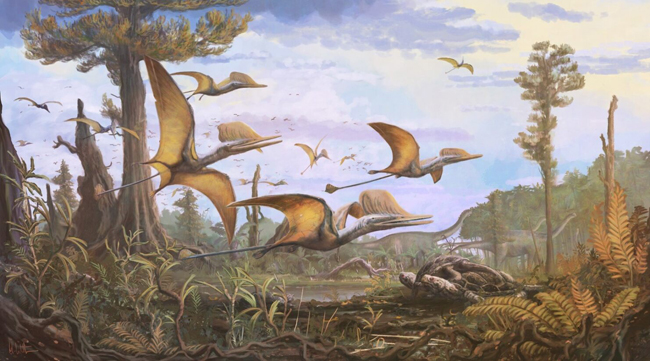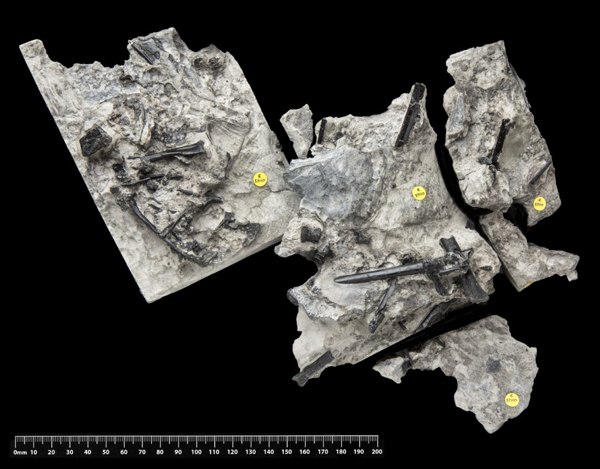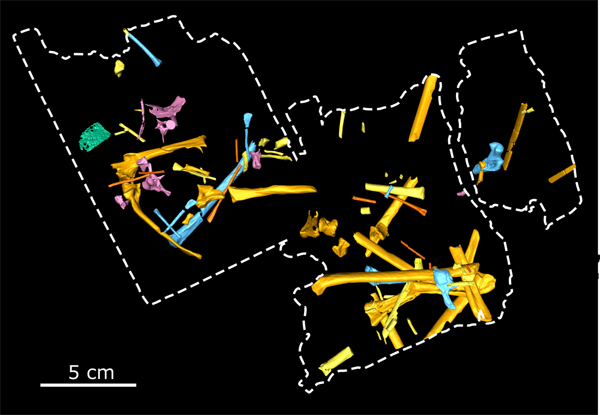New Species of Jurassic Pterosaur from the Isle of Skye
A new species of Jurassic pterosaur has been described based on fossils found on the Isle of Skye. The new flying reptile has been named Ceoptera evansae (Ki-yo-op-ter-rah evans-say). It lived around 168-166 million years ago (Bathonian faunal stage of the Middle Jurassic). It has been classified as part of the controversial Darwinoptera clade. The discovery of Ceoptera demonstrates that this clade was considerably more diverse than previously thought. The Darwinoptera are now thought to have persisted for more than twenty-five million years and probably had a worldwide distribution.

The artist has depicted a single, slender-winged pterosaur soaring high above the Ceoptera flock. We suspect that this is a representation of the recently described rhamphorhynchid Dearc sgiathanach.
To read an article about D. sgiathanach: Fantastic Pterosaur from the Isle of Skye.
The Kilmaluag Formation
The fossil remains were found partially exposed on a large boulder situated a few metres from the cliffs on the north side of Glen Scaladal at Cladach a’Ghlinne, a small beach that forms part of the coastline of Loch Scavaig, on the Strathaird Peninsula, Isle of Skye. The fossil bearing rocks are associated with the Kilmaluag Formation. The density and hardness of the matrix, coupled with the fragile nature of the fossil bones made the specimen unsuitable for mechanical preparation.
A complex process of acid bath immersion was undertaken to weaken the matrix and to expose the bones. The acid immersion, stabilising via rinsing and oven drying was repeated twenty-nine times in order to get the bones suitably prepared for analysis and CT scanning.

Ceoptera evansae
The discovery of Ceoptera underpins a new and more complex model for the early evolution of pterosaurs. Flying reptile fossils from the Middle Jurassic are extremely rare. Those that have been found are relatively incomplete and fragmentary. Whilst no cranial material is associated with Ceoptera evansae, this discovery demonstrates that the major Jurassic pterosaur clades were present before the end of the Early Jurassic.
The fossils also provide important new information concerning the geographic and stratigraphic range of the controversial clade Darwinoptera. It had been thought that this species-poor group were largely restricted to the Upper Jurassic of eastern Asia. With the discovery of Ceoptera it suggests that these pterosaurs were both temporally and geographically widespread.
Many of the bones remain completely embedded in rock and can only be studied using CT-scanning. This pterosaur is one of the first flying reptiles to be digitally assessed using scans and computer modelling.
Senior author of the paper, Professor Paul Barrett (London Natural History Museum), stated:
“Ceoptera helps to narrow down the timing of several major events in the evolution of flying reptiles. Its appearance in the Middle Jurassic of the UK was a complete surprise, as most of its close relatives are from China. It shows that the advanced group of flying reptiles to which it belongs appeared earlier than we thought and quickly gained an almost worldwide distribution.”

Ceoptera evansae – What’s in a Name?
The generic name is derived from the Scottish Gaelic word cheò or ceò (pronounced ‘ki-yo’), meaning mist. This is a reference to the common Gaelic name for the Isle of Skye Eilean a’ Cheò, or Isle of Mist), and the Latin ptera, meaning wing (feminine).
The species name honours Professor Susan E. Evans. It was Professor Evans who first became aware of the Glen Scaladal site’s potential for vertebrate fossils.
Lead author Dr Liz Martin-Silverstone, a palaeobiologist at the University of Bristol explained:
“The time period that Ceoptera is from is one of the most important periods of pterosaur evolution, and is also one in which we have some of the fewest specimens, indicating its significance. To find that there were more bones embedded within the rock, some of which were integral in identifying what kind of pterosaur Ceoptera is, made this an even better find than initially thought. It brings us one step closer to understanding where and when the more advanced pterosaurs evolved.”
Everything Dinosaur acknowledges the assistance of the press team at the University of Bristol and a media release from the London Natural History Museum in the compilation of this article.
The scientific paper: “A new pterosaur from the Middle Jurassic of Skye, Scotland and the early diversification of flying reptiles” by Elizabeth Martin-Silverstone, David M. Unwin, Andrew R. Cuff, Emily E. Brown, Lu Allington-Jones and Paul M. Barrett published in the Journal of Vertebrate Paleontology.
The Everything Dinosaur website: Everything Dinosaur.

